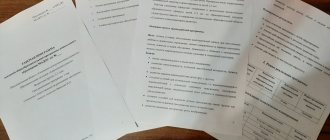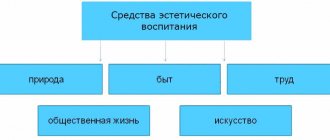Directions of psychological diagnostics
- Screening examination (monitoring) to analyze the dynamics of mental development, identifying people in need of psychological help.
- Identification of the level of readiness or adaptation of children and students to new educational conditions.
- Identification of features and possible causes of maladaptation in order to determine directions for providing psychological assistance.
- Studying the interests, inclinations, abilities of children and students, prerequisites for giftedness.
- Diagnostics of the socio-psychological climate of the team.
- Diagnosis of intellectual, personal and emotional-volitional characteristics.
Based on these areas of psychological diagnostics, the educational psychologist selects methods and techniques that he will use in his work with children. You can find a list of some techniques below.
Cheat sheets for educational psychologists at preschool educational institutions
Cheat sheets
educational psychologists of preschool educational institutions
Toolkit.
Part 1.
.
This methodological manual was written based on documents of the Russian Federation and general requirements for organizing the activities of educational psychologists in educational institutions. The manual provides a detailed description of the main reporting documentation of a preschool educational institution psychologist, its structure and samples of completion. The first part describes the step-by-step preparation of an annual plan, cyclogram, specialist journals, programs and analytical report. This manual contains both standard forms and the psychologist’s own developments in maintaining documentation, which, in the author’s opinion, are more rational and convenient.
The manual also contains the Code of Ethics for Psychologist and the order of the Ministry of Education and Science on the distribution of working time, which is an important normative support for specialists.
The manual is addressed to psychologists working or studying in this specialty, as well as methodologists and heads of preschool educational institutions for assistance and monitoring the work of educational psychologists.
It is recommended for use in the activities of educational psychologists of preschool educational institutions.
From the author.
When I started working as a psychologist, I encountered great difficulties and differences of opinion regarding the organization of work, maintaining documentation, using certain diagnostics, and finding programs for work. Most novice psychologists encounter this. Perhaps it is the lack of models and a proper system for organizing work that leads to “turnover” of personnel in educational institutions. Young specialists do not have time to cope with their work, and they also have to carry out various additional assignments and social burdens. Taking into account all these difficulties and my experience in overcoming them, this manual was written.
Theoretical and practical materials will be useful not only for beginners, but also for experienced psychologists to search for new ideas, improve organizational and methodological skills and directions for their work. The manual will also be useful as a reference for preparing for certification.
The manual is addressed to psychologists working or studying in this specialty, as well as methodologists and heads of preschool educational institutions for assistance and monitoring the work of educational psychologists.
The manual consists of several parts.
The first part reflects the documentation of psychologists and examples of how to fill it out.
The second is devoted to diagnostics, conclusions, protocols, diagnostic kits, a review of methods and programs for working with all participants in the educational process.
Areas of activity of a teacher-psychologist at a preschool educational institution.
Chapter 1. Where to start?
A teacher-psychologist must begin work by completing documents and becoming familiar with his job descriptions. Knowledge of job responsibilities, rights, functions and responsibilities allows you to resolve controversial and conflict situations. You must be able to justify your refusal to fulfill certain requirements or unwanted work, and know when and who to turn to for help.
It is very important to monitor orders issued at the federal, regional and city levels in order to promptly respond to changes in activities and take the necessary measures. To do this, you can use the Internet or periodicals.
The documents required for each educational psychologist and subject to verification by higher authorities are:
1.
Annual plan
2.
Cyclogram (work schedule).
3.
Consultation journal
4.
Card of psychological examination of the pupil.
5.
Conclusion based on the results of the psychodiagnostic examination.
6.
Journal of correctional work.
7.
Program of correctional and developmental classes.
8.
Analytical report on the work of a teacher-psychologist for the academic year.
Additional documentation:
Logs of work performed, by area.
1.
Journal of group forms of work with parents and teachers (trainings, seminars, Schools for parents, group consultations). It reflects the dates, topics, category of participants (teachers, parents, psychologists), and their number.
2. Journal of group correctional, developmental and preventive work with children. The names of the children in this working group, the dates of classes, their topics and attendance are reflected here.
3. Diagnostic work log indicating
- dates of examination,
- last name and first name of the child (group of children of parents, teachers),
- treatment code - the purpose of diagnosis (determination of the level of current development - U, assessment of the emotional and volitional sphere - E, behavioral problems - P, learning problems - O, educational problems - B, readiness for schooling - D),
- the nature of the diagnosis - indication of specific methods, questionnaires.
These journals are convenient for reflecting current activities, compiling statistical reports throughout the year and for the annual report.
It is recommended to draw up a Monthly Plan, and for novice specialists a Weekly Plan or keep a work diary, where all specific activities are planned or recorded by hour and area of activity.
Work plan for ___________ month.
(it is recommended to expand the sheet)
| Direction of work | Types of work, contingent | date | |||||||||||||||||
| Preventive work and education | |||||||||||||||||||
| Diagnostics | |||||||||||||||||||
| Correctional and developmental | |||||||||||||||||||
| Advisory | |||||||||||||||||||
| Organizational and methodological | |||||||||||||||||||
In the second column, the activities are indicated, for example, Group classes according to Kataeva’s program, with whom it is held - children of the preparatory and senior groups, put + under the specific date and the lesson number according to the thematic plan - No. 7.
Work plan for October 12 – 16.
| Mon 16. 10 | Time spending | Type and form of work | Location |
| from 8 to 9.00 | Selection of material and preparation of a parent meeting (Preparatory group) “Soon to school” | Library | |
| From 9 to 9.30 | Group preventive lesson in the junior group “Joy” | Cabinet | |
| Report | During the week, 8 group lessons were held with children, 1 workshop for teachers, a parent meeting, 7 individual lessons, 8 children and 3 parents were diagnosed. | ||
It is convenient to hang this plan on the office door or corner so that parents, teachers and managers can learn about your work.
To systematize accumulated materials, it is recommended to create a number of folders, each of which should have a list of materials contained in it:
1 Normative documents
the UN Convention on the Rights of the Child
must be present Constitution of the Russian Federation, Regulations on the service of practical psychology of education in the Russian Federation; Code of Ethics for Educational Psychologists (Appendix 1). 1 Organizational and methodological
documentation
containing
the annual plan;
work schedule; job descriptions; photocopies of documents on completion of advanced training courses; Order of the Min. Education and Science dated March 27, 2006 No. 69 “On the peculiarities of working hours and rest time for teaching and other employees of educational institutions” (or an extract from it) - see Appendix 2; Forms 1-10 (depending on the type of preschool institution); document on the approximate distribution of the working time of a teacher-psychologist - see Appendix 3, thematic plans for workshops, trainings, group preventive and correctional and developmental classes with children. 1 Advisory, educational and preventive work
, where to enter all
photocopies of interesting materials, sources of literature on this topic, titles of journal articles with a source mark... You can systematize the material into three categories: children, parents, teachers
.
1 All this will allow you to quickly find information on the desired topic, easily prepare consultations, meetings, leaflets, classes for all categories of the educational process.
1 Implementation of the annual plan,
where to put all the seminars held, parent meetings, trainings, leaflets, etc., which will help track the volume and quality of your work, and take this into account when planning your work for the next year.
1 List of methods used.
This folder allows you to quickly find the necessary diagnostics, reduce the time required to maintain a diagnostic log, where the number of the technique is simply written down, and not its name, author and nature. It is presented in the form of a table. The columns indicate the method number according to the list, name, its purpose category (children, parents, teachers), author, year of publication or modification, literary source.
1 List of developmental, correctional, preventive programs used.
The number of the program in the list, the name of the program, focus, author, and literary source are indicated. It will allow, depending on the diagnostic results, to select appropriate preventive and correctional and developmental material.
1 Thematic lesson plans.
For example, according to the programs used with children. They allow you to quickly prepare the necessary materials for the lesson and reflect its content. You can use the columns lesson number, topic or title, content (listing of exercises used), materials. If you plan to use the program for more than one year, then specific dates of classes can be written in pencil under the topic in accordance with their cyclicity. When working with teachers, this can be a group work plan, indicating goals, objectives, listing
content and forms of work, responsibilities and deadlines.
1 Thematic folders.
They collect material on topics (aggressive children, hyperactive children, anxious children, memory, attention, imagination, perception, thinking, children 2-3 years old, 3-4, 4-5, 5-6), various activities, consultations, information materials.
1 Archives.
When a new group is formed in a kindergarten, an archive folder is created for it, where all materials for this group will be stored until graduation (questionnaires for parents, children's drawings, protocols...). These folders are kept for another 5 years after the children are released from the preschool educational institution.
Chapter 2. How to properly maintain documentation.
1. ANNUAL PLAN.
When drawing up an annual plan, it is necessary to use the recommended form (Form 1), which is mandatory for all preschool institutions. We also present 2 acceptable modifications of this form, dictated by the convenience of working with them. (Form 1A and 1B).
When starting to write a plan, it is necessary to study the goals and objectives of the preschool institution for the school year, the program according to which the kindergarten operates, and reflect this in an explanatory note
to your annual plan.
Based on these data, the psychologist determines his goal and work objectives for the year. If you have work experience
, then it is necessary to determine priorities in work based on last year’s results, analysis of the psychological climate in the preschool educational institution, children’s problems, requests from parents, teachers, and administration. In the explanatory note, it is advisable to briefly indicate the relevance of the chosen goal and objectives of the work used in the work of the program.
In order not to waste time on drawing up several overlapping plans, it is recommended to draw up a detailed annual plan indicating specific activities, diagnostics, consultations and classes.
| Annual plan structure | Writing Guidelines | |
| Heading (title page) | Long-term work plan for 20__ - 20__ academic year Teacher psychologist MDOU No. Full name Experience, category or rank | Certified by the head of the preschool educational institution and the head of the GMO of educational psychologists of the city preschool educational institution. |
| Explanatory note | The main tasks of kindergarten. | Determined by the management of the preschool educational institution (methodologist, head) |
| Kindergarten program(s): | ||
| Analysis of work experience. | Last year’s work results, features of the psychological climate in the preschool educational institution, children’s problems, requests from parents, teachers, and administration are taken into account. | |
| The purpose of the work of an educational psychologist | There must be one, for its implementation narrower and more specific tasks are selected. Or it is not indicated at all, replaced by work priorities | |
| Tasks of the work of an educational psychologist | There shouldn't be many of them. The plan requires measures to achieve these objectives | |
| Priority areas and programs | Provide a list of programs used, indicating the author and name of the program | |
| Plan | Forms 1, 1A or 1 B are used |
Target.
One of the proposed formulations may be chosen.
— Psychological support of the educational process in preschool educational institutions.
— Creating conditions for preserving and strengthening the psychological health of participants in the educational process.
Tasks
(according to various sources).
Depending on the characteristics of the preschool educational institution and the orientation of the educational psychologist, various tasks can be set:
— Timely identification of children in need of psychological help and creation of conditions for their harmonious development.
— Promoting the full mental and personal development of children.
— Study of individual characteristics of children’s development in the unity of the intellectual, emotional and volitional spheres of their manifestation.
— Providing psychological assistance to children, parents and teachers at all stages of the educational process (adaptation, interaction, preparation for school).
— Promoting the improvement of the psychological competence of preschool teachers and parents in matters of training and education of preschool children.
— Teaching preschoolers ways to overcome difficulties, ways to regulate their emotions and behavior.
— Establishing interaction and mutual understanding between participants in the pedagogical process.
— Promoting the introduction of... an approach into the educational process (depending on the tasks of the preschool educational institution, the city, the development of innovative projects, the availability of experimental sites. For a sample of psychologist support for similar work, see the journal Preschool Education No. 9, 2000, p. 42)
— Development and implementation of group preventive and correctional development programs.
— Development and implementation of individual psychocorrection programs.
— Selection of psychological literature for self-education of parents.
- other
Plan.
The annual plan should reflect:
1.
All areas of activity of a teacher psychologist:
— psychoprophylactic work
— psychodiagnostic work
— correctional and developmental work
— advisory work and psychoeducation
— organizational and methodological work
The implementation of these directions is carried out through various types of activities and with all participants in the educational process (children, parents, teachers).
Psychoprophylactic, advisory work
and
psychoeducation
can be presented:
o preventive classes with children of all ages once a week (for example, Khukhlaeva O.V., Khukhlaev O.E., Pervushina I.M. Program of psychoprophylactic classes for children 3-4, 4-5, 5-6 years old) ;
o speeches at parent meetings on preschool plans, requests and your wishes;
o organizing clubs and schools for parents on current topics, assigned work tasks, and requests;
o conducting ongoing seminars and workshops for teachers (for example, Typical problems of preschool children, Overcoming stress and emotional burnout of teachers...);
o training work with children, parents (for example, Lyutova E.K., Monina G.B. Training in communication with a child), teachers (for example, Monina G.B., Lyutova E.K. Communicative training and the program of activities of a teacher-psychologist in an educational institution to preserve the psychological health of teachers - newspaper School Psychologist, ), psychological games;
o a periodically updated corner, a newspaper, a stand with information (for example, Why a psychologist in kindergarten, How to teach a child to put things in order...);
o individual consultation reflected in the cyclogram (based on diagnostic results, upon request to solve current problems and issues);
o It is mandatory to highlight your activities at teachers’ councils (at the beginning of the year about tasks and plans, at the end of the year about achievements).
Diagnostics:
Basic rule:
there should not be too much diagnostics, it should have a purpose and result. Those. The survey conducted should be analyzed quantitatively and qualitatively, and correctional and developmental work should be carried out based on the results.
˚ At the beginning of the school year (August-September or September-October), cognitive development is diagnosed
children using diagnostic kits for each age group.
Based on its results, psychological development cards are filled out for each child. The emotional and volitional development
is also monitored (during the year, depending on work priorities). For this purpose, observations of various routine moments, special testing, conversations, and surveys of teachers and parents are carried out. Based on the diagnosis, RISK and DEVELOPMENT groups are formed, and children are identified for individual and subgroup work.
˚ In the middle and at the end of the year, interim
and
final
diagnostics of children attending psychologist classes to monitor the dynamics of corrected and developed processes.
˚ At the end of the year, a study of the level of readiness for schooling
children of the preparatory group in blocks (intellectual, personal, motivational readiness). Based on the results, medical records are filled out and recommendations are given to parents.
˚ In the summer and throughout the year, as children enter kindergarten, adaptation
, questionnaires and conversations with parents about the child’s readiness to enter kindergarten, collecting information about the new child, assistance in adaptation.
group and individual diagnostics of teachers and parents can be planned throughout the year
to solve current problems and increase interest in psychological knowledge (for example, to conduct a “Carrot and Stick” meeting, an anonymous questionnaire is conducted to identify the prevailing methods of influence in education, or to assess the psychological atmosphere in a team).
˚ If conditions exist, computer testing can be organized, which arouses more interest and trust, because It’s not a psychologist who processes the results, but a computer.
Corrective and developmental work:
o For group correctional and developmental work with children, you can use ready-made programs (for example, Kataeva L.I. Program of correctional and developmental classes for children of senior preschool age (6-7 years), or you can independently develop a system of classes, recording it according to Form No. 9 (Appendix 4) This will be considered an author’s development, which during certification is rated higher than the use of ready-made programs and lesson developments.
o For individual work, the program is compiled for each child individually. It is possible to work using notebooks (for example, with homework for working with parents on the development of motor skills), games with sand, water, dolls - depending on the experience, priorities of the psychologist, and the child’s problems.
o Working with the family (joint activities with the child and parent)
o Workshops, meetings, trainings with parents and teachers on ready-made or compiled programs.
Organizational and methodological work.
˚ Drawing up an annual plan, annual report, cyclogram, maintaining journals and other reporting documentation.
˚ Compilation of questionnaires, diagnostic complexes, selection and production of materials for diagnostics, processing of diagnostic results, summarizing, writing certificates and reports.
˚ Preparation for classes with children, selection of content, materials, preparation of correctional and developmental programs.
˚ Preparation for individual and group consultations, seminars, meetings with parents and teachers.
˚ Filling out cards of psychological development of children, individual development routes, documents for the Risk group.
˚ Visit to the library, city methodological office, GMO psychologists to improve scientific and psychological-pedagogical qualifications.
˚ Preparation of information leaflets for parent corners.
˚ Practical work to develop the educational and methodological base of the office.
˚ Mutual visits.
The plan must necessarily reflect all 12 months of work, because It is not always possible to take vacation time into account; the summer months can be combined (if planning is monthly) or spelled out in detail in the organizational and methodological block.
2.
Types of activities (events) must be specific. For example (see sample plans for details):
| Direction of work | Kind of activity | |
| Psychodiagnostics | Children | î Diagnostics of cognitive processes – Diagnostic complexes for children 3-4 years old, 4-5 years old, 5-6 years old, 6-7 years old. î Ladder technique. î Group technique Coding î Observations during classes and walks î Test Temll, Amen, Dorki î Intermediate diagnosis of children at risk î Final diagnosis of children at risk î Determination of readiness for school (Kern-Ierasek Test, verbal-logical thinking, motivational readiness) |
| Teachers | î Questionnaire survey “My group”, Questionnaire “Wishes for the year”. î Determination of the level of anxiety, professional stress, neuropsychic stability (No. 14,25, 26, computer diagnostics). o On request. | |
| Parents | î Questionnaire for the preparatory group, for the secondary group, etc. o Diagnosis of child-parent relationships (Parental essay). o On request. | |
3.
Object of activity and conditions (specific group of children - junior 1-2, middle, senior, preparatory, parents, teachers and form of work - individual, group).
4.
Not only an educational psychologist, but also educators (for example, when questioning parents or identifying the characteristics of a group), a methodologist (when preparing a workshop seminar or pedagogical council), and specialized specialists (when conducting joint events) can be responsible.
5.
Dates, frequency (during the year, May, once a month)
6.
Expected result (formulations like: formation..., filling out a psychological development card, assessing the level of development..., identifying children at risk...)
Form 1
.
| № p/p | Job title | Conditions | Responsible | Date | Expected result |
Diagnostics of adaptation to preschool education
Monitoring a child during the adaptation period is an important diagnostic direction in the work of a psychologist. It allows you to collect data about the child and draw a conclusion about the degree of adaptation to kindergarten. There are many techniques with which you can carry out this observation. I suggest you get acquainted with the list of some of them.
- Ronzhina A.S. “Diagnostics of the level of adaptation of a child to a preschool institution.”
- Methodology of A. Ostroukhova “Studying the degree of adaptation of a child at a preschool educational institution.”
- Methodology of Vatutina N. D. “Determination of the degree of adaptation to preschool educational institutions.”
Diagnosis of readiness for school
- Yasyukova L.A. Methodology for determining readiness for school.
- Semago N.N., Semago M.Ya. “Psychological and pedagogical assessment of readiness to start school.”
- Ekzhanova E.A. "Diagnostic and prognostic screening in the first grades of secondary schools."
- Varkhatova E.A., Dyatko N.V., Sazonova E.V. "Express diagnostics of readiness for school."
- Method of express diagnostics of intellectual abilities of children 6-7 years of age (MEDIS)
- Kern-Jirasek School Maturation Test.
Diagnostics of cognitive processes
Now there are many different diagnostic kits, which have already selected all the necessary methods for diagnosing cognitive processes in children of different ages. All you have to do is choose which one you like best. Below I have provided a list of the most popular ones.
- Rudenko L.G., Pavlova N.N. Express diagnostics in kindergarten: a set of materials for educational psychologists in preschool educational institutions.
- Rudenko L.G., Pavlova N.N. Psychological diagnostics and correction at an early age.
- Strebeleva E.A. Psychological and pedagogical diagnostics of the development of children of early and preschool age.
- Kurazheva N.Yu., Kozlova I.A., Tuzaeva A.S. Diagnostic complex “Tsvetik-Semitsvetik” for children 3-7 years old.
- Zabramnaya S.D., Borovik O.V. Practical material for psychological and pedagogical examination of children
EXPERT WORK
Expert activity is a special way of studying innovative phenomena and processes in education to discover the potential for further development (G.A. Mkrtychyan, 2002).
The main areas of expert work in preschool educational institutions:
- Participation in the development of the regulatory, legal and documentation framework for the functioning of a psychological, medical and pedagogical council on the basis of preschool educational institutions for the support of children with special educational needs (disabilities).
- Study of the influence of the social situation of development on the characteristics of the child’s psyche.
- Study of the effectiveness of students’ assimilation of the educational program.
- Participation in the formation of a subject-development environment that meets the requirements of the zone of proximal development and the current level of development of the child.
- Monitoring compliance with preventive measures that help relieve psycho-emotional stress in children and staff - correction of routine aspects (organization of sleep, nutrition, optimization of motor activity, training of the body’s thermoregulatory system).
Diagnostics of personal and emotional-volitional characteristics
- Methodology “Emotional faces” (N.Ya. Semago) (Goal: assessing the possibility of adequate recognition of the emotional state, the accuracy and quality of this recognition.)
- Anxiety test (Temml R., Dorki M., Amen V.) (Purpose: determining the level of anxiety).
- Test for identifying children's fears A.I. Zakharov and M. Panfilova “Fears in houses” (Goal: identifying and clarifying the prevailing types of fears in children over 3 years old).
- Eight-color Luscher test (Purpose: study of the child’s emotional state).
- “Ladder” technique. Modified by S.G. Yakobson, V.G. Shchur. (Purpose: self-esteem research).
- “Locomotive” technique (S.V. Velieva) (Goal: determining the characteristics of the child’s emotional state).
- Methods for studying children's self-awareness (N.L. Belopolskaya) (Purpose: to study the level of formation of those aspects of self-awareness that are associated with the identification of gender and age).
- Graphic technique M.A. Panfilova “Cactus” (Goal: identifying the state of the child’s emotional sphere, identifying the presence of aggression, its direction and intensity).
- Methodology “Magic Land of Feelings” (Purpose: study of the psycho-emotional state of the child).
- Makhortova G.Kh. Projective methodology for personality research “Tell a story.” (Purpose: personality research).
Diagnosis of parent-child relationships
In the standard “Teacher-psychologist (psychologist in the field of education)” such an area as diagnosing child-parent relationships is not highlighted, but I felt that it needed to be voiced. After all, we must work with the child in conjunction with all participants in educational relations. Therefore, it is very important for us to understand what kind of relationships a child has in his family and how this can affect his behavior and development.
- Projective technique “Family Drawing”. This technique is aimed at diagnosing emotional well-being and the structure of family relationships.
- Test “Diagnostics of emotional relationships in the family” Authors E. Bene and D. Anthony (under the general editorship of A.G. Leaders and I.V. Anisimova). This test is aimed at studying the emotional relationships of a child in the family.
- Rene Gel's projective technique. Research into the sphere of a child’s interpersonal relationships and his perception of intrafamily relationships
- Children's Apperception Test (CAT) (Authors: Leopold and Sonya Bellak)
EDUCATIONAL WORK
Psychological education is an important component of the preventive direction of the work of an educational psychologist. In modern society, psychological knowledge and skills are not yet widespread enough, especially respect for the characteristics of a child’s personality. Also, in teaching teams and in families, conflicts are possible, based on the inability and unwillingness to understand one’s own relationships, experiences, actions, to listen to each other, to understand. The main purpose of psychological education is to acquaint educators and parents with the basic patterns and conditions for the favorable mental development of a child, explain the results of psychological research, and create the need for psychological knowledge and the desire to use it in working with a child or in the interests of developing one’s own personality. Psychological education takes place in the form of lectures, conversations, seminars, distribution of printed materials, publications on the MBDOU website.





